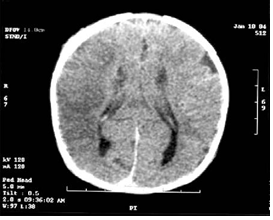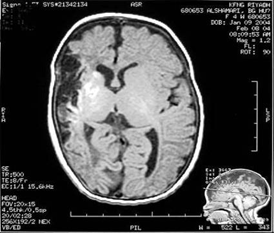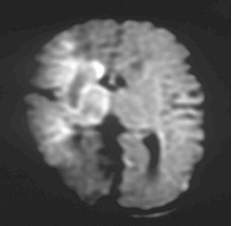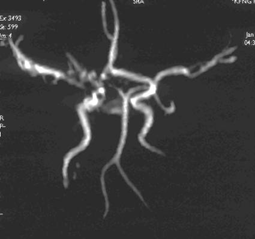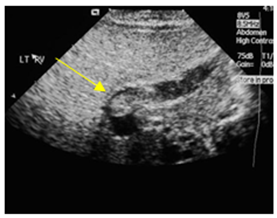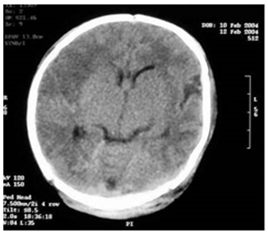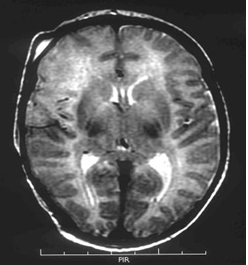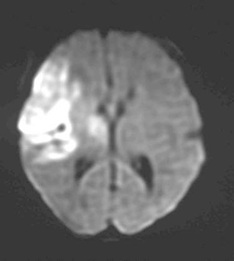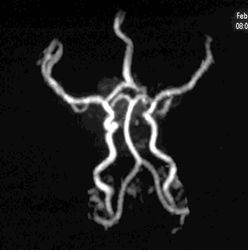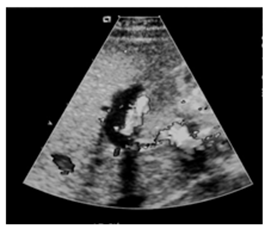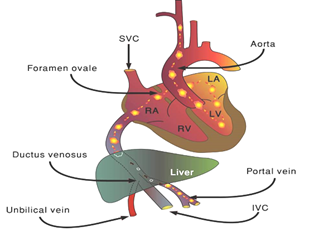Portal Vein Thrombosis can be the Cause for Neonatal Cerebral Infarction-Case Report and Review of the Literature
Article Information
Waleed Altuwaijri1*, Saif Alsaif2, Mohammad Alghamdi3, Abdullah Yousef M Aldaffaa4
1Pediatric Neurologist, King Abdullah Specialist Children Hospital, Riyadh, Saudi Arabia
2Neonatologist, King Abdulaziz Medical City, Riyadh, Saudi Arabia
3Neonatologist, King Fahd Hospital of The University, Khobar, Saudi Arabia
4King Saud bin Abdulaziz University for Health Sciences, Riyadh, Saudi Arabia
*Corresponding Author: Waleed Al-Tuwaijri, Pediatric Neurologist, King Abdullah Specialist Children Hospital (KASCH), Riyadh, Saudi Arabia
Received: 20 September 2019; Accepted: 07 October 2019; Published: 14 October 2019
Citation:
Waleed Altuwaijri, Saif Alsaif, Mohammad Alghamdi, Abdullah Yousef M Aldaffaa. Portal Vein Thrombosis can be the Cause for Neonatal Cerebral Infarction-Case Report and Review of the Literature. Journal of Pediatrics, Perinatology and Child Health 3 (2019): 186-193.
View / Download Pdf Share at FacebookAbstract
Neonatal cerebral infarction occurs rarely in healthy term neonate and extremely rare if associated with portal vein thrombosis. We reported two cases with this association and discussed the unique mechanisms of cerebral infarction. We proposed that in the absence of any identifiable cause for the cerebral infarction, portal vein thrombosis can be the cause, and Doppler sonography for portal system worth to be done.
Keywords
Portal Vein Thrombosis, Doppler sonography, Neonatal Cerebral Infarction
Portal Vein Thrombosis articles, Doppler sonography articles, Neonatal Cerebral Infarction articles
Article Details
1. Introduction
Neonatal cerebral infarction is a rare event in healthy term neonate. The incidence of symptomatic strokes is about 1:4000 in term babies [1], when it happens, it can present as a seizure during the first days or pass asymptomatically. A number of risk and predisposing factors have been investigated. We reported two cases of cerebral infarction with unique mechanisms of cerebral infarction that involve thrombosis found in the portal system. We proposed that in the absence of any identifiable cause for the cerebral infarction, portal vein thrombosis can be the cause, and Doppler sonography for portal system worth to be done.
2. Case Presentation
2.1 Case 1
The is full term female infant product of vacuum extraction due to prolonged second stage of labor and poor maternal effort.with Apgar scores of 9 and 9 at 1 and 5 minutes, respectively, and birth weight of 3500 gm born to 29-year-old, Saudi lady primigravida with history of prolong rupture of membrane for 27 hrs on antibiotic IV 2 doses prior to delivery with no fever. Umbilical cord blood gases were normal. At 11 hours of age the infant developed jerky movement of the left upper arm lasted for 1 minute, which were followed by two more episodes of left sided seizures, ranging in duration from 15 seconds to 2 minutes. Urgently she was transferred to NICU A loading dose of phenobarbitone (20 mg/kg) was giving, complete septic work-up was done and antibiotic started, serum electrolytes were normal. In NICU, no further seizure activity was noted. Computed tomography of the brain was done at age of 15 hours, which showed subtle hypo density with effacement of the sulci over right cerebral hemisphere in the frontotemporaparietal lobe representing right middle cerebral artery infarct and subdural bleed along the straight sinus (Figure 1).
Magnetic resonance imaging (MRI) confirmed the infarct in the territory of the right middle cerebral artery involving the right frontotemporalparietal lobes as well as the right thalamus and basal ganglia (Figure 2).
Magnetic resonance diffusion weighted image showing acute infarcts involving the right frontotemporalparateial lobes (Figure 3).
MRI angiography revealed a subtotal blockage of the proximal right middle cerebral artery presumably by thrombus. Filling defects noted in the distal branches of right middle cerebral artery suggesting small emboli (Figure 4).
An electroencephalogram showed epileptiform activity over right hemisphere Echocardiography showed normal heart structure with patent Forman ovale. liver Doppler sonography done and there was decreased peak flow velocity in the left portal vein with presence of thrombus (Figure 5).
The result of septic work up including lumber puncture were normal, serum ammonia, lactate, pyruvate and metabolic screen where negative. Liver function tests and urine screen for homocysteine were normal. The coagulation profile (prothrombin time, activated partial thromboplastin time, thrombin time, platelet count, fibrinogen, and von Willebrand factor antigen. The prothrombotic screen included measurement of factor VIIIc, protein C, protein S, antithrombin. In addition, the presence of the factor V Leiden mutation, and antiphospholipid antibody levels were all came be appropriate for age. Baby was appropriately anticoagulated initially with IV infusion of heparin for one week which was shifted to low molecular weight heparin and discharged home with it. As follow up case one, had complex partial seizure controlled with Tegretol, with mild motor deficit over left upper limb. Portal vein thrombosis resolved at age of one month where subcatnousally administrated low molecular weight heparin discontinued.
2.2 Case 2
A full-term male neonate was born to a 33-year-old multigravida mother, (G8 P7) her antenatal course was uncomplicated. A vacuum extraction was performed following prolonged second stage of labor after epidural anesthesia. Apgar scores were 7 at one minute and 9 at five minutes. birthweight 3560 gm Umbilical cord blood gases were normal. Baby noticed to had grunting with no desaturation, his general exam revealed a large cephalohematoma over the right parietal bone with bulging over right side of the chest and decreased air entry in the same side, there was no murmurs and the rest of the neurological assessment was normal. chest X-ray done and reveled right side nontension pneumothorax, which resolved after venous catheter chest tap, chest X-ray film repeated after 6 hours and reveled no pneumothorax. At 43 hours of age a three-minute episode of rhythmic twitching of the left hand and foot occurred. A loading dose of phenobarbitone (20 mg/kg) was given and followed by two similar episodes. Computed tomography of the brain showed low-density area in the right frontoparietal region. (Figure 6).
Magnetic resonance imaging (MRI) confirmed the infarct in the left posterior frontal lobe (Figure 7).
Magnetic resonance diffusion weighted images demonstrating the infarction (Figure 8).
MRI angiography revealed no abnormality (Figure 9).
An electroencephalogram (EEG) showed evidence of epileptiform activity over right frontal head region. Echocardiography showed normal heart structure, with patent Forman ovale Liver Doppler sonography done, and there was decreased peak flow velocity in the left portal vein with presence of thrombus (Figure 10).
Serum ammonia, lactate, pyruvate and metabolic screen where negative. Liver function tests and urine screen for homocysteine were normal. The coagulation profile (prothrombin time, activated partial thromboplastin time, thrombin time, platelet count, fibrinogen, and von Willebrand factor antigen. The prothrombotic screen included measurement of factor VIIIc, protein C, protein S, antithrombin. In addition, the presence of the factor V Leiden mutation, and antiphospholipid antibody levels were all came be appropriate for age. Baby was appropriately anticoagulated initially with IV infusion of heparin for one week which was shifted to low molecular weight heparin and discharged home with it. As follow up case two, evaluated clinically on periodic interval which reveled no neurological deficit however the baby had two attack of febrile convulsion at age of 7th and 8th months. Portal vein thrombosis resolved at age of five month and low molecular weight heparin discontinued soon after.
3. Discussion
Although thromboembolic disease in the neonate is relatively uncommon, its management remains a challenge. Over 80% of thrombotic events in neonates are associated with venous or arterial catheters [2]. Symptomatic neonatal stroke occurs in about one in 4000 term neonates [1]. Ischaemic stroke after the first month of life occurs with an annual incidence rate of about one in 2300-5000 children [3]. No information is available on the frequency of neonatal strokes that were asymptomatic in the nursery period and were diagnosed later. Unless followed by disability leading to neuroimaging in later months or years, such strokes remain unrecognized. Racial and gender differences have been identified for paediatric stroke, but such information is not available for neonatal stroke.
Until recently, neonatal infarctions were mainly detected in infants who suffered from birth asphyxia or other severe conditions.It is now well recognized that they are more common in infants with no history of birth asphyxia who develop convulsions in the first 2 ± 3 days of life Current data suggest that 7.5-20% of neonatal seizures can be attributed to stroke, making it the second most common cause of neonatal seizures [4]. Risk factors for neonatal stroke have been assessed on limited evidence from selected case series and case reports. The mechanisms by which ischaemic stroke occurs in the include thromboembolism from an intracranial or extracranial vessel, or the heart or placenta, commonly the source is undetermined.
Regarding portal vein thrombosis. It has 3 grades based on the Thrombus and liver parenchymal echogenicity. Grade 1 non-occlusive thrombus in the portal vein with normal liver parenchymal echogenicity, grade 2 occlusive thrombus with normal liver parenchymal echogenicity, grade 3 occlusive thrombus with abnormal liver parenchymal echogenicity [5], the incidence of in neonates is unknown. The most common cause is instrumentation, particularly umbilical vein catheterization [6]. Other causes include sepsis, hyperviscous state, venous compression, and hypercoagulability [6]. Portal hypertension is a serious long-term complication of portal vein thrombosis [6]. Follow-up for neonates with portal vein thrombosis for at least 5 years after being diagnosed should be started to prevent GI bleeding for them later [7]. Other complication of PVT is lobar liver atrophy, but it seems to be of little significance in the childhood age [7].
Our infants neither had any identifiable risk factors for portal vein thrombosis nor neonatal stroke, apart from that they both born by vacuum extraction, Kumar et al. report contralateral cerebral infarction following vacuum extraction [8] but vacuum extraction cannot explained the presence of portal vein thrombosis Mercuri et al. in their prospective study of neonatal cerebral infarction found that prothrombotic conditions including the factor V Leiden mutation and elevated factor VIII are common in neonates with cerebral infarction which is not the cause in our babies [9]. Several studies reported on EEG changes in infants with neonatal cerebral infarction, ranging from focal slowing of background activities to focal spikes and sharp waves, with or without abnormal background activity [4].
Walsh B et al. reported EEG abnormalities can change with sleep state and disappear during active sleep [4]. Radiographic studies in neonatal stroke include CT, MRI, magnetic resonance angiography (MRA) and, less frequently, conventional angiogram. Cranial ultrasound plays only a limited role in neonatal stroke term newborns due to the peripheral location within the brain of most infarcts.
We did Cranial ultrasound in case two due to presence of pnemothorax aiming to exclude intracranial haemorrahge prior to his convulsion. However cranial ultrasound failed to detect cerebral infarction. Both CT and MRI confirm and characterize infarcts in terms of number, size, vascular territory, and the presence or absence of hemorrhagic conversion. MRI is more sensitive to small or early infarcts that are frequently missed by CT [3], as in the first case which was reported to us initially, as normal however we proceed to MRI. The radiographic technique that detects infarction in its earliest stages is the diffusion weighted MRI scan. In the latter technique, abnormal focal findings indicating cytotoxic edema precede abnormalities on a regular MRI sequence in newborns [3]. MRA in case two was normal which can be explained by rechannelization or presence of collateral since it was done on the 4th day of life.
Neonatal seizure history and the findings on neurologic examination associated with long-term outcome of neonatal stroke. While Mercuri et al. [9] reported neonatal clinical examination was not always predictive of the outcome. The extent of the lesion on MRI was a better predictor. In particular, it was the concomitant involvement of hemisphere, internal capsule and basal ganglia that was always associated with an abnormal outcome whereas the involvement of only one or two of the three tended to be associated with a normal outcome. Also, he reported EEG to be very helpful. Abnormal background activity either unilateral or bilateral was associated with abnormal outcome (hemiplegia). In contrast, the presence of seizure activity in presence of a normal background was not related to abnormal outcome. Our babies both had seizure with abnormal EEG.
Parker et al. [10] reported two cases of neonatal cerebral infarction often occurs in the absence of described known risk factors in which portal vein thrombosis was documented during two-dimensional echocardiography. For our two babies it was the first time to recommend Doppler sonography for portal system, aiming to explain why our babies had neonatal cerebral infarction since two-dimensional echocardiography missed.
We strongly believed that emboli from a portal vein thrombus could passed through the ductus venosus and foramen ovale to entered systemic circulation and caused cerebral infarction (Figure 3). We do know that renal venous thrombosis (RVT) is by far the most common manifestation of neonatal thrombosis. Both renal Doppler sonography was normal for our babies. Analysis of the placenta might have given important information to support the embolization hypothesis. Unfortunately, we have not been able to do this as the infants in our population were thought normal at birth and it is not routine to keep placentas of low-risk infants.
The optimal treatment of thromboembolic lesion in newborns is uncertain since current guidelines are extrapolated from studies in adults and older children, which is not optimal. Options include thrombolytic therapy; or close monitoring of the thrombus with objective tests and treating with anticoagulants if extension occurs. . As they suggested for symptomatic venous thromboembolism and if clinicians elected to anticoagulation therapy, to administered UFH (unfractionated heparin) or LMWH (low molecular weight heparin) and subsequently administered LMWH for 10 days to 3 months.
Our decision to use LMWH was made because subcutaneous injection obviates the requirement of dedicated intravenous access and there is less need for laboratory monitoring as compared with UFH. The optimal use, dosage, efficacy, and bleeding toxicity of tissue plasminogen activator (TPA) thrombolysis in children and neonate are unknown, so we elected not to treat with it. We do know that use of warfarin is very problematic in newborns for several reasons. there is essentially no information on its efficacy and safety in newborns again we elected not to treat with warfarin. We propose that in absence of any identifiable cause for neonatal stroke with presence of portal vein thrombosis, the cerebral infarction may be considered due to portal vein thrombosis and Doppler sonography for portal system worth to be done.
Acknowledgements
We acknowledge both infants and their families, radiology section in King Fahad National Guard Hospital.
References
- Lynch JK, Nelson KB. Epidemiology of perinatal stroke. Curr Opin Pediatr 13 (2001): 499-505.
- Thornburg C, Pipe S. Neonatal thromboembolic emergencies. InSeminars in Fetal and Neonatal Medicine 11 (2006): 198-206.
- Lequin MH, Dudink J, Tong KA, et al. Magnetic resonance imaging in neonatal stroke. InSeminars in Fetal and Neonatal Medicine 14 (2009): 299-310.
- Walsh BH, Low E, Bogue CO, et al. Early continuous video electroencephalography in neonatal stroke. Developmental Medicine and Child Neurology 53 (2011): 89-92.
- Morag I, Epelman M, Daneman A, et al. Portal vein thrombosis in the neonate: risk factors, course, and outcome. The Journal of pediatrics 148 (2006): 735-739.
- Ferri PM, Ferreira AR, Fagundes ED, et al. Portal vein thrombosis in children and adolescents: 20 years experience of a pediatric hepatology reference center. Arquivos de gastroenterologia 49 (2012): 69-76.
- Williams S, Chan AK. Neonatal portal vein thrombosis: diagnosis and management. InSeminars in Fetal and Neonatal Medicine 16 (2011): 329-339.
- Kumar M, Avdic S, Paes B. Contralateral cerebral infarction following vacuum extraction. Am J Perinatol 21 (2004): 15-17.
- Mercuri E, Cowan F, Gupte G, et al. Prothrombotic disorders and abnormal neurodevelopmental outcome in infants with neonatal cerebral infarction. Pediatrics 107 (2001): 1400-1404.
- Parker MJ, Joubert GI, Levin SD. Portal vein thrombosis causing neonatal cerebral infarction, Arch Dis Child Fetal Neonatal Ed 87 (2002): 125-127.

